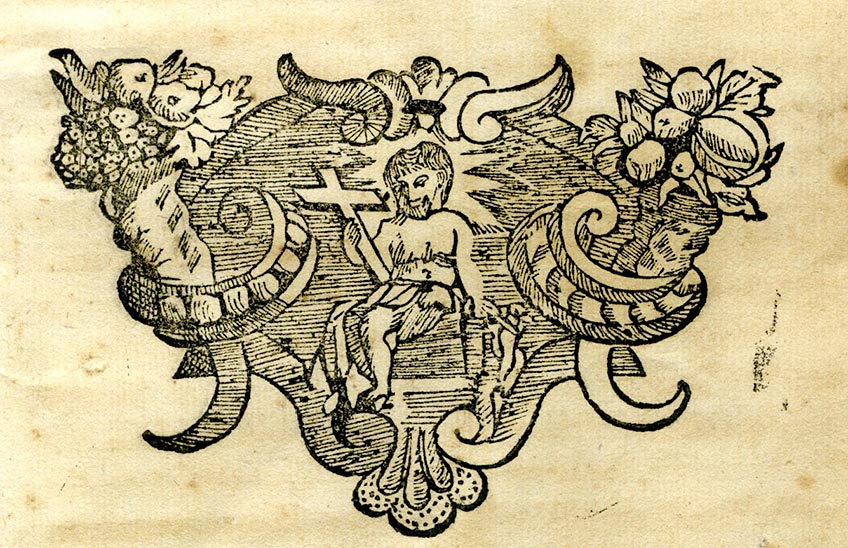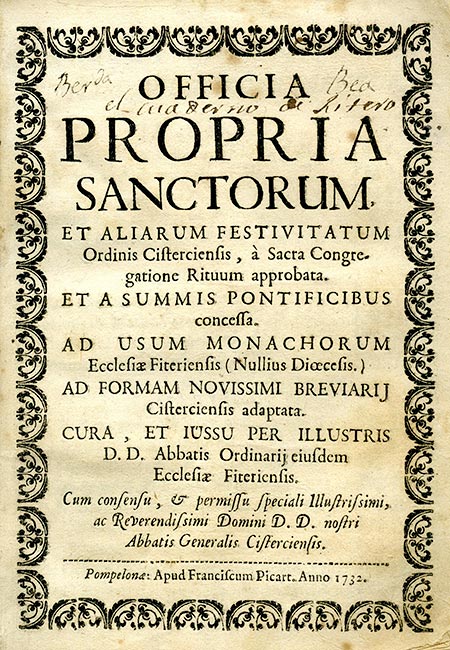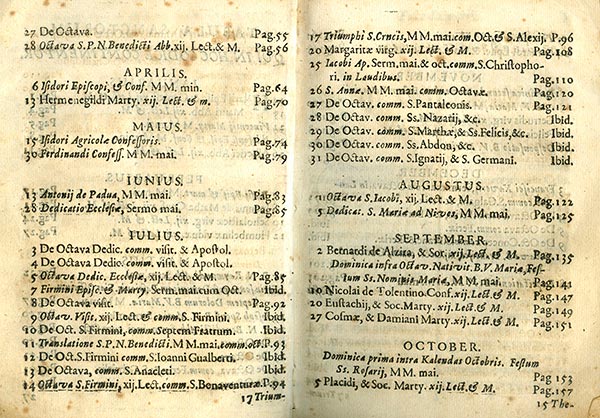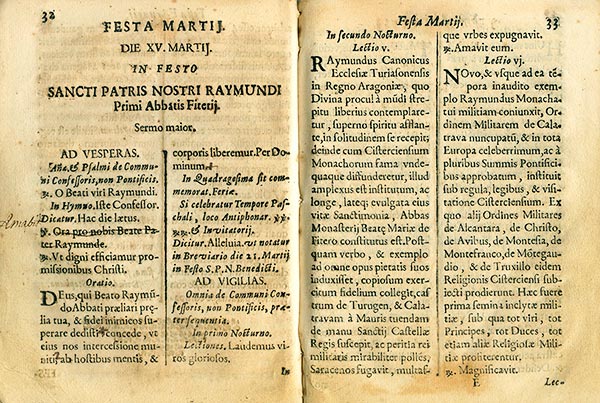An unknown book, published in Pamplona, for the monastery of Fitero in 1732.

FotoRicardoFernández Gracia/Colophon of the book published in Pamplona for the monastery of Fitero in 1732.
They are not usually mere coincidences, but some actions of the superiors in their monasteries are due to causalities. Thus we have to understand the edition, in 1732, of a liturgical guide destined to the monastery of Fitero, of whose record there is no news in the repertoires to the use, neither in the editions in paper, like the great A repertoire of the Jesuit father Pérez Goyena, nor in the digital repositories like in Catalog Collective of the Spanish Bibliographic Patrimony.
It is no coincidence that coinciding with the aforementioned edition, the monastery of Fitero experienced a veritable building and artistic fever in the thirties of the 18th century. Among other works, we should mention the construction of the sacristy between 1725 and 1730, the decoration of the abbey Library Services with rich plasterwork around the same time, the construction of the great chapel of the Christ of the guide with all its decoration - today of the Virgin of La Barda - between 1732 and 1736, as well as the pulpit (1733) and the altarpiece of Santa Teresa (1730).
internship position Ignacio de Hoyos y Beroiz (1728-1733), a native of San Sebastián who had taken the habit in 1694 and died in 1758, after having served as Vicar General of the Cistercian Congregation of Aragon and Navarre, and in that capacity had visited the monastery of Leire in 1730, leaving the usual mandates for the perfection of monastic life.

Cover of the book of offices of the monastery of Fitero, 1732.
The book
All these artistic works were complemented by a careful liturgy. For the order of the liturgy, it was essential for the monks, in particular, to have a printed book with all the details of the offices to be celebrated throughout the year. It was clear that they had to have a common version, without handwritten copies that had been amended a thousand times. The printed book was the best guarantee of order in the divine offices, something that was a constant in the history of the church, particularly after the Council of Trent.
The book is extremely rare, in fact, I only know of one in a private collection and another incomplete one in the Library Services of the monastery of La Oliva. The title page of the book is the one that provides us with the most information data. It states that the offices contained therein were those proper to the saints and feasts of the Cistercian Order approved by the Sacred Congregation of Rites, following the form of the recently published Cistercian Breviary, which can be none other than the one published in Madrid in 1727, with degree scroll de Officia propia sanctorum et aliarum festivitatum Ordinis Cisterciensis a Sacra Rit. Congregat. aprobata.

Index with the table of offices of the monastery of Fitero, 1732.
The book has no approbation, foreword or dedication. It begins with a table of the feasts organised by months. The various celebrations are marked with readings, antiphons, verses, etc., corresponding to the different canonical hours.
The date obviously includes the official document of Saint Raymond Abbot of Fitero, the first abbot of the monastery. As we have already written elsewhere, the liturgical official document of the saint was authorised in stages. The prayer and official document of the first abbot of Fitero and founder of the Order of Calatrava was gradually authorised for the Cistercian Order (1702), for the diocese of Tarazona (1728) and for other religious orders and the kingdom of Navarre (1787), until 1800, when it was extended to the whole of Spain, at the request of Charles IV, by means of a Brief issued in Rome on 5 December 1800, extending the official document of his feast day to all the regular and secular clergy of both sexes of all the Hispanic dominions, with the category of double minor rite for the 15th of March.
The monastery of La Oliva emulated that of Fitero and, in 1767, published its Oficios, printed by Pascual Ibáñez, of which the aforementioned Pérez Goyena gives an account in register 2274 of his essay of bibliography in Navarre.
The printer
The man chosen to do the printing was Francisco Picart (†1743), of Aragonese origin although his works are documented in Pamplona, where he married in 1687. His output spanned several decades between the early 18th century and 1734, when he was succeeded by his first-born son Martín Francisco due to health problems. In the Navarrese capital he worked for important clients such as the Royal Courts and the General Hospital. Among the publications that the aforementioned institution had at a standstill were the Oficios de la diócesis de Pamplona (Offices of the Diocese of Pamplona). His publishing projects included some lives of saints and volumes IV and V of the Annals of Navarre, the work of Francisco Alesón.
Moreover, Picart must have been well known in the Cistercian monasteries, since in 1714 he printed the second volume of the Summa moralis, the work of the monk Bernardo Pacheco, enlarged and arranged by the Riojan member of the clergy Don Manuel Rico and dedicated to the bishop of Calahorra Don Alonso de Mena y Borja.

Prayers for the feast of Saint Raymond of Fitero, in the book published in Pamplona in 1732.
To find out more
FERNÁNDEZ GRACIA, R., "Entre la historia, la leyenda y el mito: La imagen de San Raimundo, abad de Fitero y fundador de la Orden de Calatrava", Fitero: el bequest de un monasterio, Pamplona, Fundación para la Conservación el Patrimonio Histórico de Navarra, 2007, pp. 287-315.
ITÚRBIDE, J., Escribir e imprimir: el libro en el Reino de Navarra en el siglo XVIII, Pamplona, Government of Navarre, 2007.
PÉREZ GOYENA, A., essay de bibliography Navarra desde la creación de la imprenta en Pamplona hasta el año 1910, vol. III, Pamplona, Príncipe de Viana, 1951.
